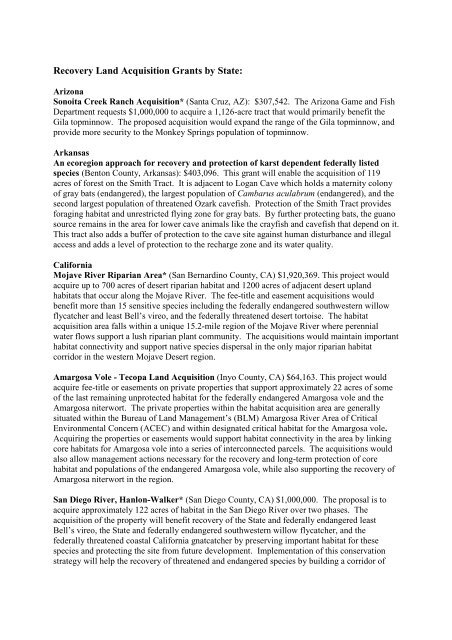Habitat Conservation Plan Land Acquisition Grants by State:
Habitat Conservation Plan Land Acquisition Grants by State:
Habitat Conservation Plan Land Acquisition Grants by State:
Create successful ePaper yourself
Turn your PDF publications into a flip-book with our unique Google optimized e-Paper software.
Recovery <strong>Land</strong> <strong>Acquisition</strong> <strong>Grants</strong> <strong>by</strong> <strong>State</strong>:<br />
Arizona<br />
Sonoita Creek Ranch <strong>Acquisition</strong>* (Santa Cruz, AZ): $307,542. The Arizona Game and Fish<br />
Department requests $1,000,000 to acquire a 1,126-acre tract that would primarily benefit the<br />
Gila topminnow. The proposed acquisition would expand the range of the Gila topminnow, and<br />
provide more security to the Monkey Springs population of topminnow.<br />
Arkansas<br />
An ecoregion approach for recovery and protection of karst dependent federally listed<br />
species (Benton County, Arkansas): $403,096. This grant will enable the acquisition of 119<br />
acres of forest on the Smith Tract. It is adjacent to Logan Cave which holds a maternity colony<br />
of gray bats (endangered), the largest population of Cambarus aculabrum (endangered), and the<br />
second largest population of threatened Ozark cavefish. Protection of the Smith Tract provides<br />
foraging habitat and unrestricted flying zone for gray bats. By further protecting bats, the guano<br />
source remains in the area for lower cave animals like the crayfish and cavefish that depend on it.<br />
This tract also adds a buffer of protection to the cave site against human disturbance and illegal<br />
access and adds a level of protection to the recharge zone and its water quality.<br />
California<br />
Mojave River Riparian Area* (San Bernardino County, CA) $1,920,369. This project would<br />
acquire up to 700 acres of desert riparian habitat and 1200 acres of adjacent desert upland<br />
habitats that occur along the Mojave River. The fee-title and easement acquisitions would<br />
benefit more than 15 sensitive species including the federally endangered southwestern willow<br />
flycatcher and least Bell’s vireo, and the federally threatened desert tortoise. The habitat<br />
acquisition area falls within a unique 15.2-mile region of the Mojave River where perennial<br />
water flows support a lush riparian plant community. The acquisitions would maintain important<br />
habitat connectivity and support native species dispersal in the only major riparian habitat<br />
corridor in the western Mojave Desert region.<br />
Amargosa Vole - Tecopa <strong>Land</strong> <strong>Acquisition</strong> (Inyo County, CA) $64,163. This project would<br />
acquire fee-title or easements on private properties that support approximately 22 acres of some<br />
of the last remaining unprotected habitat for the federally endangered Amargosa vole and the<br />
Amargosa niterwort. The private properties within the habitat acquisition area are generally<br />
situated within the Bureau of <strong>Land</strong> Management’s (BLM) Amargosa River Area of Critical<br />
Environmental Concern (ACEC) and within designated critical habitat for the Amargosa vole.<br />
Acquiring the properties or easements would support habitat connectivity in the area <strong>by</strong> linking<br />
core habitats for Amargosa vole into a series of interconnected parcels. The acquisitions would<br />
also allow management actions necessary for the recovery and long-term protection of core<br />
habitat and populations of the endangered Amargosa vole, while also supporting the recovery of<br />
Amargosa niterwort in the region.<br />
San Diego River, Hanlon-Walker* (San Diego County, CA) $1,000,000. The proposal is to<br />
acquire approximately 122 acres of habitat in the San Diego River over two phases. The<br />
acquisition of the property will benefit recovery of the <strong>State</strong> and federally endangered least<br />
Bell’s vireo, the <strong>State</strong> and federally endangered southwestern willow flycatcher, and the<br />
federally threatened coastal California gnatcatcher <strong>by</strong> preserving important habitat for these<br />
species and protecting the site from future development. Implementation of this conservation<br />
strategy will help the recovery of threatened and endangered species <strong>by</strong> building a corridor of

















